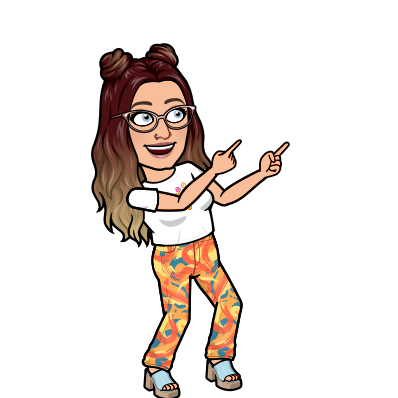
View here.

View here.
In Chapter 3 of Kevin Kumashiro’s (2006), Against Common Sense Teaching and Learning Toward Social Justice, Kumashiro discusses that teachers teach in a state of uncertainty.
What does teaching in uncertainty mean?
According to Kumashiro, teaching in uncertainty means that teachers do not know the hidden lessons they are teaching their students, and therefore do not know what their students are really learning from their lessons. In the chapter, Kumashiro discusses an example involving two different teachers. He then recounts how his own students speculated what these teachers’ students were learning from the way that the teachers taught. The speculations of Kumashiro’s students were varied, but their speculations also highlighted the fact that each student has a different lens in which they view the world and will, therefore, interpret a teacher’s teaching in a different way dependant on the student’s individuality.
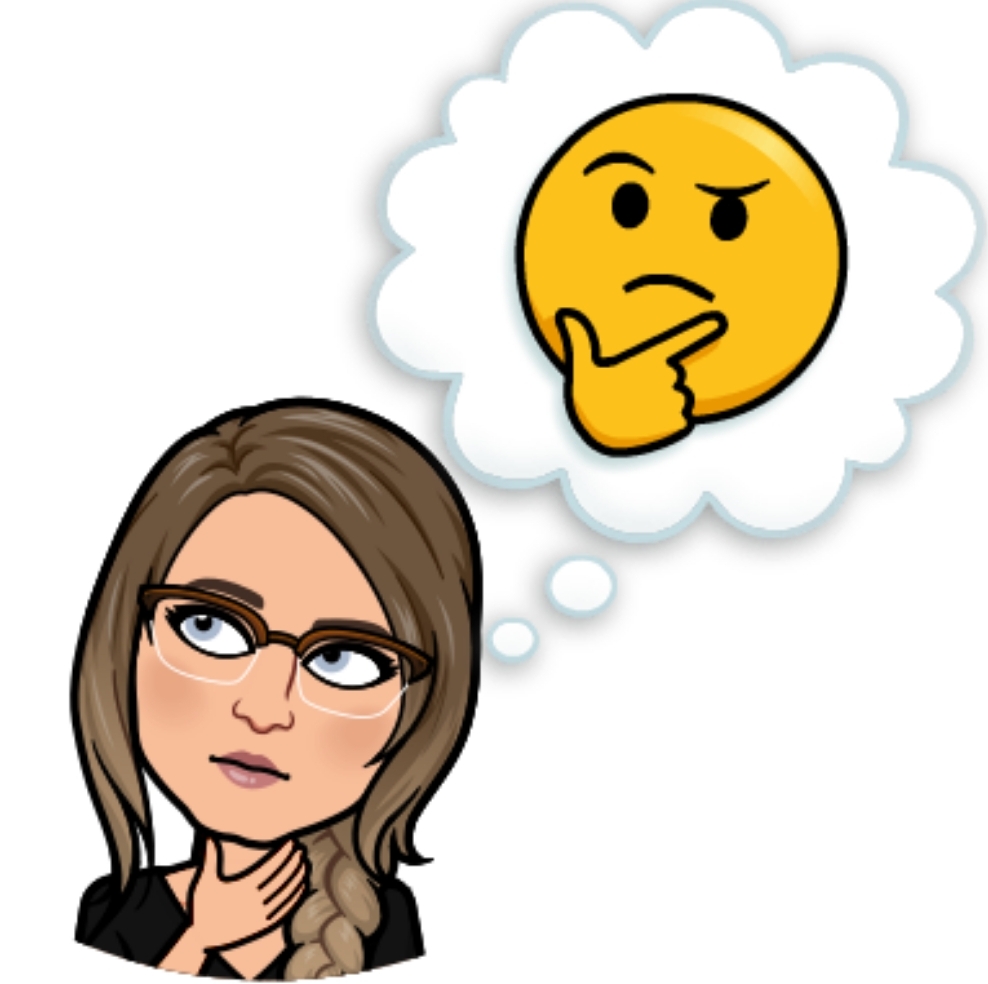
How Teaching in Uncertainty will Impact my own Teaching
Knowing that it is nearly impossible to predict or know what my student’s are learning from the way that I teach will make me more mindful of not only what I teach, but how I teach it as well. This mindfulness will encourage me to learn and observe the frames of reference each of my students’ bring to the classroom and can help me better predict when unintentional messages in my teaching could be harmful or contradictory to my intentional message.
What it Means to Teach
In my frame of reference to teach means to serve as a guide that helps students understand themselves and the world around them. A teacher is meant to encourage students to learn about themselves and the world around them so that they treat both with care and respect. Teaching also means to consistently be reevaluating and criticizing your own frame of reference and the world around you in order to learn and grow from your biases or witnessed oppression. Kumashiro discusses that we should be “radically rethinking what it means to teach in,” this idea has influenced my perception of what it means to teach (p. 41). It has influenced my perception by encouraging me to reevaluate what I believe a teacher’s role is and how teaching should be done. From this idea, I have concluded that it is essential for a teacher to consistently be in a state of reevaluation of their own practices and the world around them.
How to Address the Hidden Curriculum and Battle the Uncertainty of Teaching
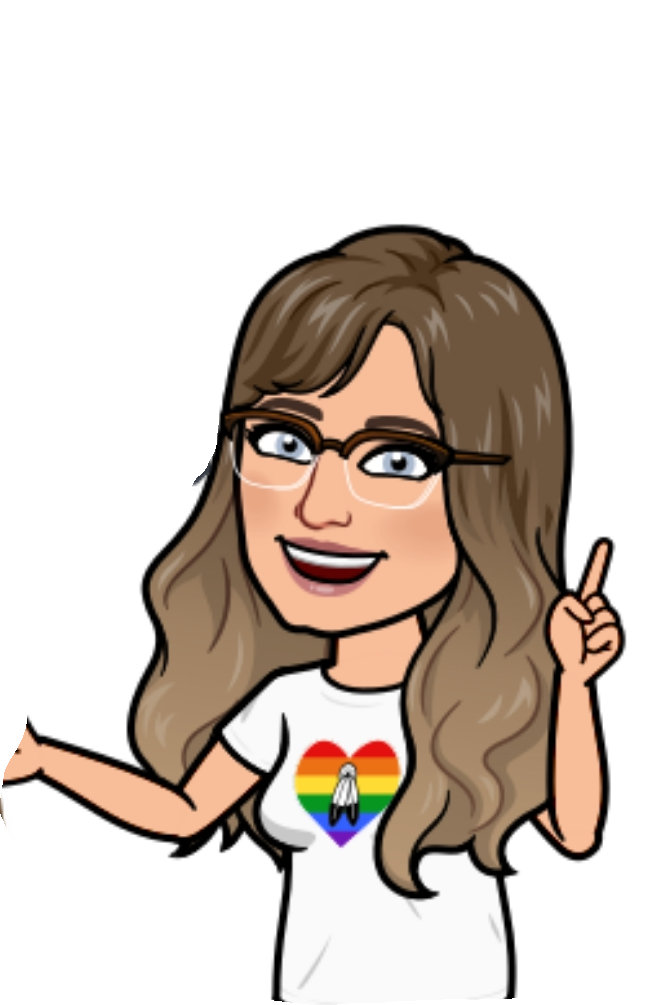
I believe that the best way for a teacher to address the uncertainty of teaching and the hidden curriculum is to first understand that each student will view your teaching in a different way, and therefore each student will learn different lessons. This understanding can help a teacher predict and combat unintentional lessons from the hidden curriculum (and their teaching) that students learn. I also think that it would be beneficial for teachers to ask students questions about the messages they are learning from their teaching, and encourage them to be honest about their answers. This tactic can highlight what impact your teaching has on your students and will provide feedback on how to be more mindful of your teaching.
How My Upbringing Taught Me To ‘Read The World‘
My upbringing and schooling heavily reflected a colonized western society. When I was a child, we lived in North Central Regina. Considering the high crime rate of that area and my parents’ own biases, my parents did not allow me to play outside alone or with other children in the neighborhood (especially Indigenous children). They also sent me to a babysitter that lived in a much nicer area (primarily white families lived there) and I went to an elementary school that was close to my babysitter’s. At my elementary school, there were mainly upper-middle-class white families. For these reasons, I was conditioned to not trust and fear people that had a different skin color than me as a child. My childhood taught me to ‘read the world’ from a cynical standpoint where white people are nice and kind, and people of color are scary and criminals. This was the case because I had very limited interactions with people of color. It was not until I was a pre-teen where I truly developed friendships with people of color and had to learn to unlearn my biases.
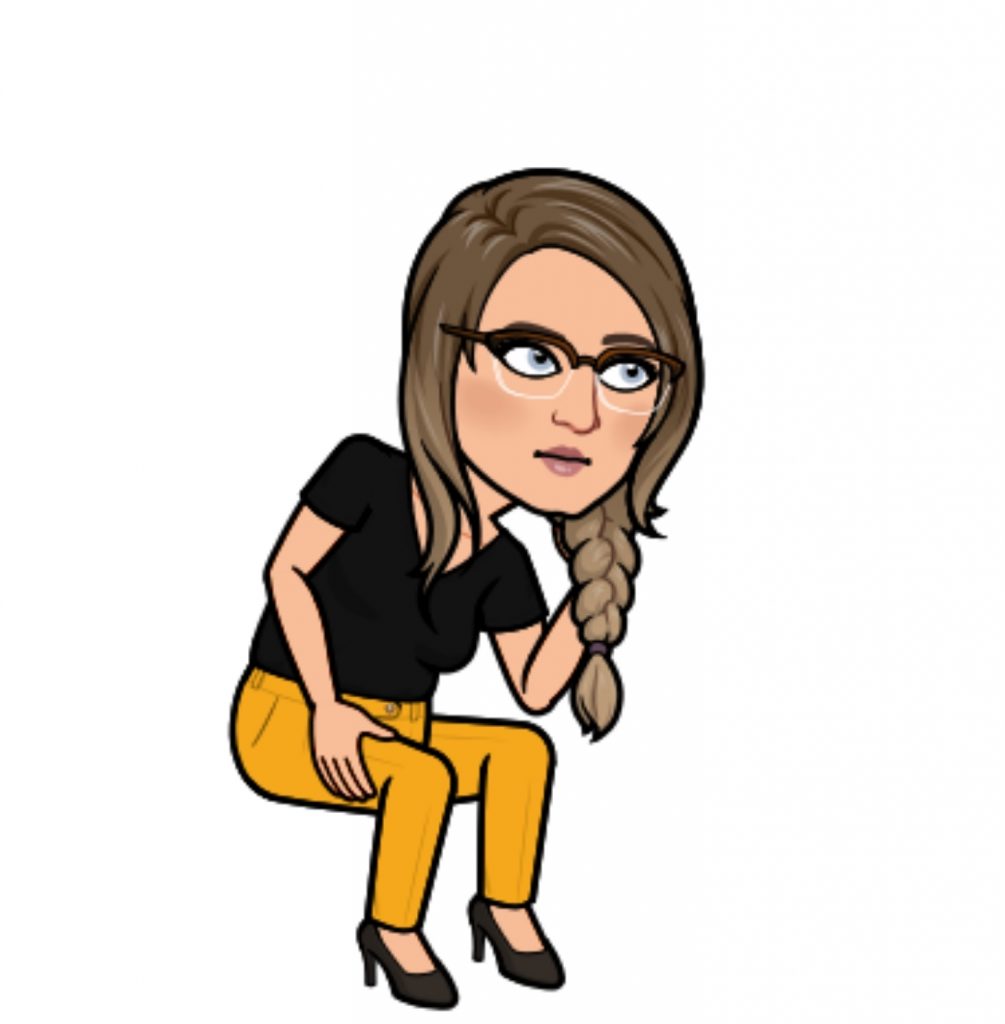
The Biases I Bring to The Classroom and How I Unlearn Them
‘What biases do you bring to the classroom?’ is the hardest (or the most shameful) question I can be asked as an upper-middle-class, straight, English speaking, white woman. However, it is for this reason that it is important to be asked and answer these types of questions. I know that I hold racial biases that influence my perception of the world. I believe that the first step to unlearning my biases is to first acknowledge that they exist. Once I acknowledge that they exist, it is easier to identify when a biased thought or action occurs and I can then work to correct that thought or action.
My Single Stories
In Chimamanda Adichie’s Ted Talk, she discusses the concept of ‘Single Stories’ or biases. In my schooling experience, we were taught from a white settler/western colonized perspective. I had limited interactions or experiences with other cultures and did not know much about other cultures as a result. It was not until I was in grade five or six that I began to learn more about Indigenous culture and genocide. Prior to learning about Indigenous culture, I had a single story about Indigenous people. This story was that all Indigenous people are alcoholics, drug addicts, poor and dangerous criminals. I learned this single-story because I was not exposed to Indigenous culture and the truth about Canadian history. This information was withheld from me for way too long, and it highlighted that white stories mattered more in my society than indigenous stories.
View here.

Originally posted July 28, 2020.
The concept of reinhabitation and decolonization is rooted in the fact that Indigenous people share a deep connection with the land and their culture. “Learning from Place: A Return to Traditional Mushkegowuk Ways of Knowing” is a research project completed by Jean-Paul Restoule, Sheila Gruner, and Edmund Metatawabin. In the project, they worked to discover the ins and outs of reinhabitation and decolonization. They did so by creating an audio documentary about taking a trip down the Albany River which served as a, “decolonizing process of re-membering as younger generations were re-introduced to traditional ways of knowing.”
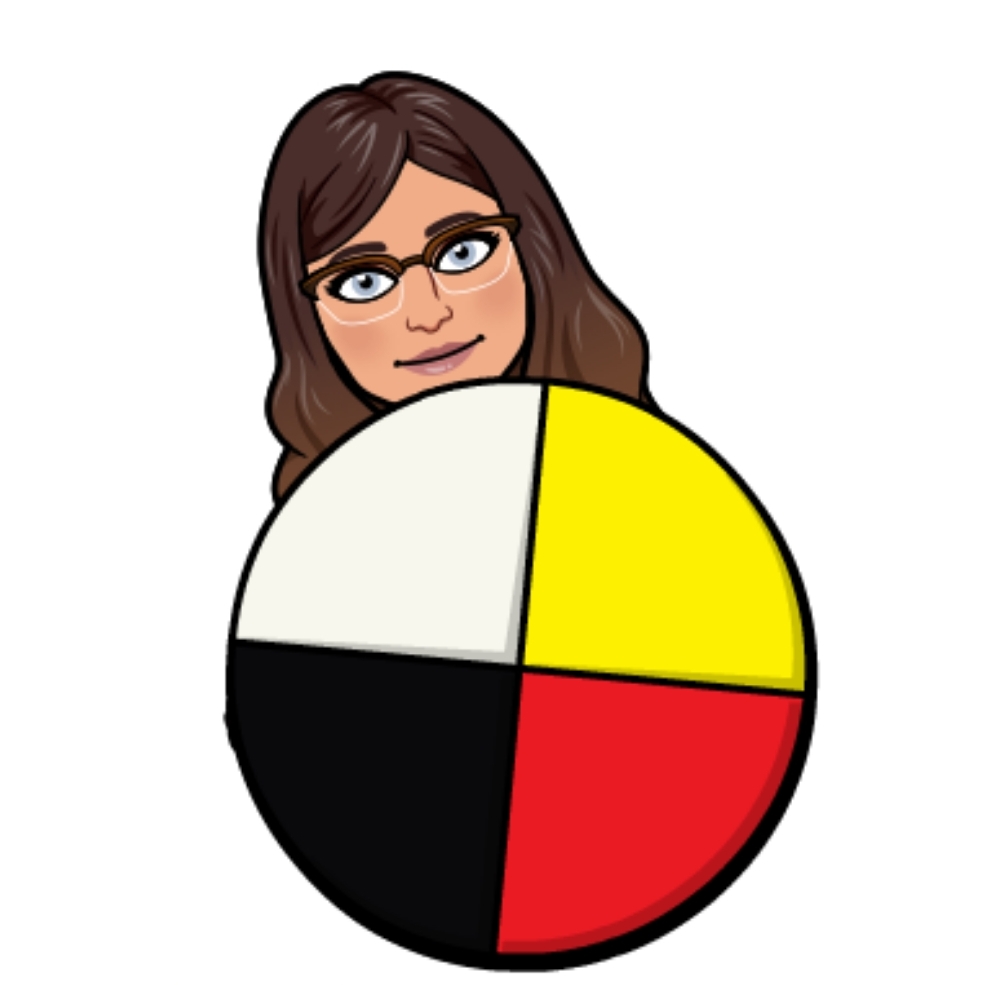
According to Restoule et al. (2013), reinhabitation and decolonization can be defined as:
Reinhabitation:
Identify, recover, and create material spaces and places that teach us how to live well in our total environments that teach us how to live well in our total environments.
Examples of Reinhabitation in the Project:
Decolonization:
Identify and change ways of thinking that injure and exploit other people and places.
Examples of Decolonization in the Project:
How would I adapt the Research Project’s ideas about Reinhabitation and Decolonization?


View here.
Originally posted July 20, 2020.
An important question to consider as an educator is ‘What do we teach and why?’. This is an important question because it allows a teacher to critically analyze the implications of what they teach and how they teach it. For this same reason, it is also important to consider how school curriculum is decided.
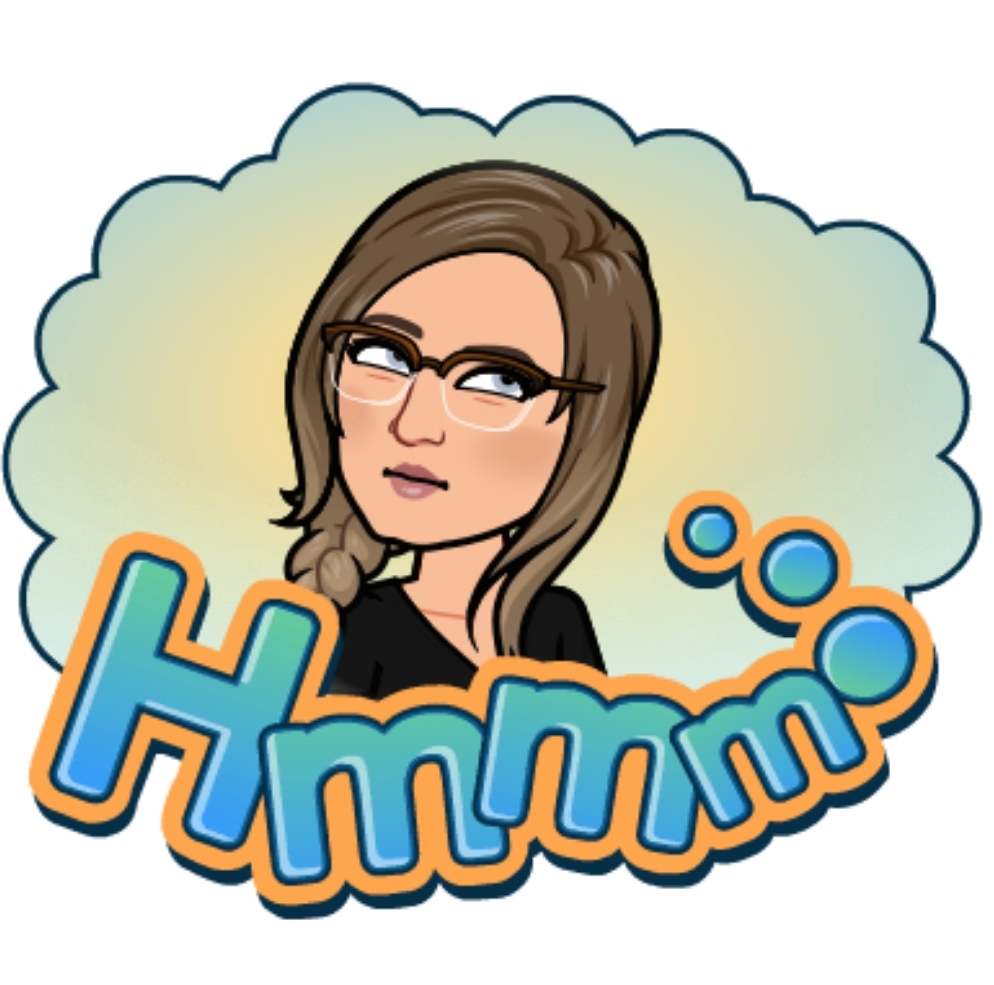
How is school curricula decided?
Curriculum is a complicated concept that involves multiple factors. These factors also play a role in how curriculum is both decided and implemented. Understanding curriculum begins with understanding it’s basic principles, “Most curricula are organized around at least two objectives — very general or broad goals and then much more specific learning activities and objectives.” (Levin, 2008, p. 14). In addition, curriculum is also influenced by multiple factors. These factors include, politics, community, students and teachers (Levin, 2008). Once these principles are understood, it is easier to understand how curricula is decided.
According to Levin (2008), curriculum is decided upon by first examining the existing curriculum, gathering data about the existing arrangements, considering various ideas for change, and then trying to arrive at consensus on recommendations for the new curriculum; all of these steps are decided by a committee of experts that include academics and teachers.
What did I gain from reading Curriculum Policy and the Politics of What Should be Learned in Schools?
What I learned from reading Levin’s article is that curriculum is not simple. Deciding on what to teach students is a complicated process that is influence by societal movements, politics, social justice issues, teachers, students, geographical location, and other factors.

My Thoughts on how Curriculum is Decided
I think that considering how complex curriculum is, it is important to reevaluate what we teach and how we teach it on a regular basis. I also believe that as a classroom teacher, there is an enormous amount of responsibility to adapt the curriculum so that it benefits each student in their classroom.
References
Originally posted November 12, 2020.
For my third Process Journal, I chose to create an Eco-Art inspired dance party playlist. I wanted to create a playlist that had both variety and songs featuring Indigenous artists. The playlist is as follows:
“Landback” was created to support the Wet’suwe’ten nation in their conflict with the Canadian government. It is a reflection of the Wet’suwe’ten nation’s connection to land and nature. I chose this song because it emphasizes the importance of our connection to land.
2. “Radioactive” – Imagine Dragons
Most people have heard “Radioactive”. In my search for songs to include in the playlist, I found this website that lists sixty-one songs about nature and the environment. “Radioactive” was included in this list. On the web-page, the author wrote, “If we’re not careful, nature as we know it will cease to be. We’ll be left with what’s in this 2012 electro-rock song, a radioactive wasteland. The narrator paints a picture of a post-apocalyptic world where he is surrounded by ash and dust and breathes in toxic chemicals.”
“Home to Me” – N’we Jinan Artists (Grassy Narrows First Nation)
N’we Jinan Artists is a program that goes to schools in Indigenous communities and collaborates with Indigenous youth to create music videos. “Home to Me” discusses respect for land and culture.
“For Our Culture” – N’we Jinan Artists (Seabird Island Community School, British Columbia)
“For our Culture” discusses how the connection to people and nature keeps them strong and united through their hardships. I chose this song because of the lyrics that talk about the importance of connection to nature.
5. “One World (We Are One)” – Taboo
Similar to the other songs in this playlist, “One World (We Are One)” talks about the importance of unity in the world for healing. I chose this song because I felt its message tied the playlist together.
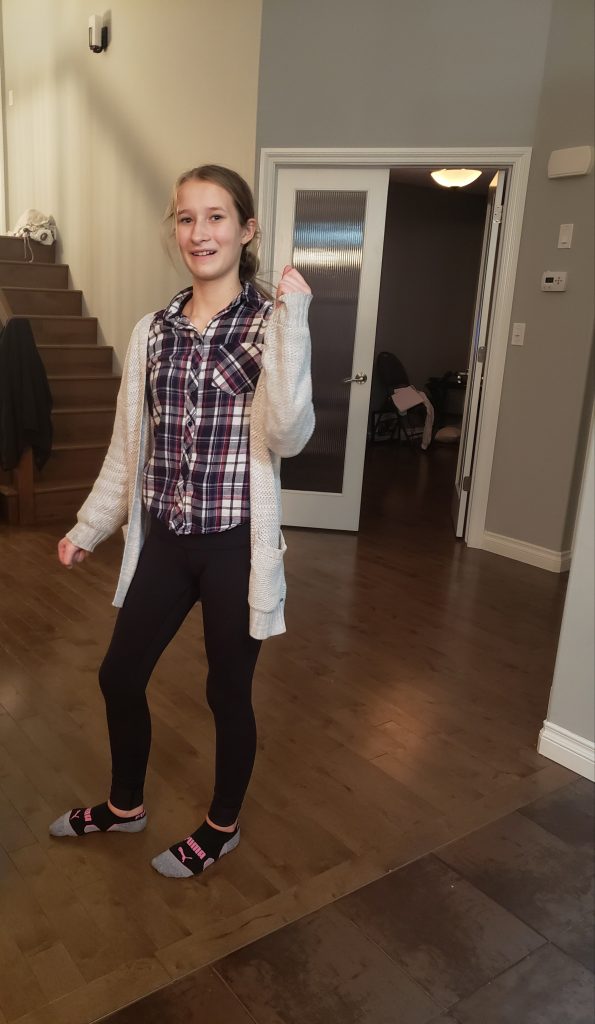
I decided to include my sister in the dance party so I did not feel lonely.
The types of movements I created varied depending on the song that was playing. During “Landback” I hopped a lot and varied how fast I was hopping based on the change in tempo. The pace of movements varied depending on the tempo in the song. In songs like “Landback” my movements were more aggressive, but in songs like “Home to Me” my movements were slower and more fluid.
Implementing an activity like this would be beneficial in my classroom because it aligns with my beliefs about education like that each student’s individuality is an important component of their education and should be used to help achieve educational outcomes.
By allowing students to move freely to the music they hear, they are able to express their individuality and own interpretation of dance. My only concern about this activity is ensuring that each student feels comfortable participating. Another way I would adapt this activity is by having students create their own playlists that were guided by personal questions about themselves.
Originally posted October 16, 2020.
For my second process journal, I decided to create a sound map based on the sounds I heard outside.
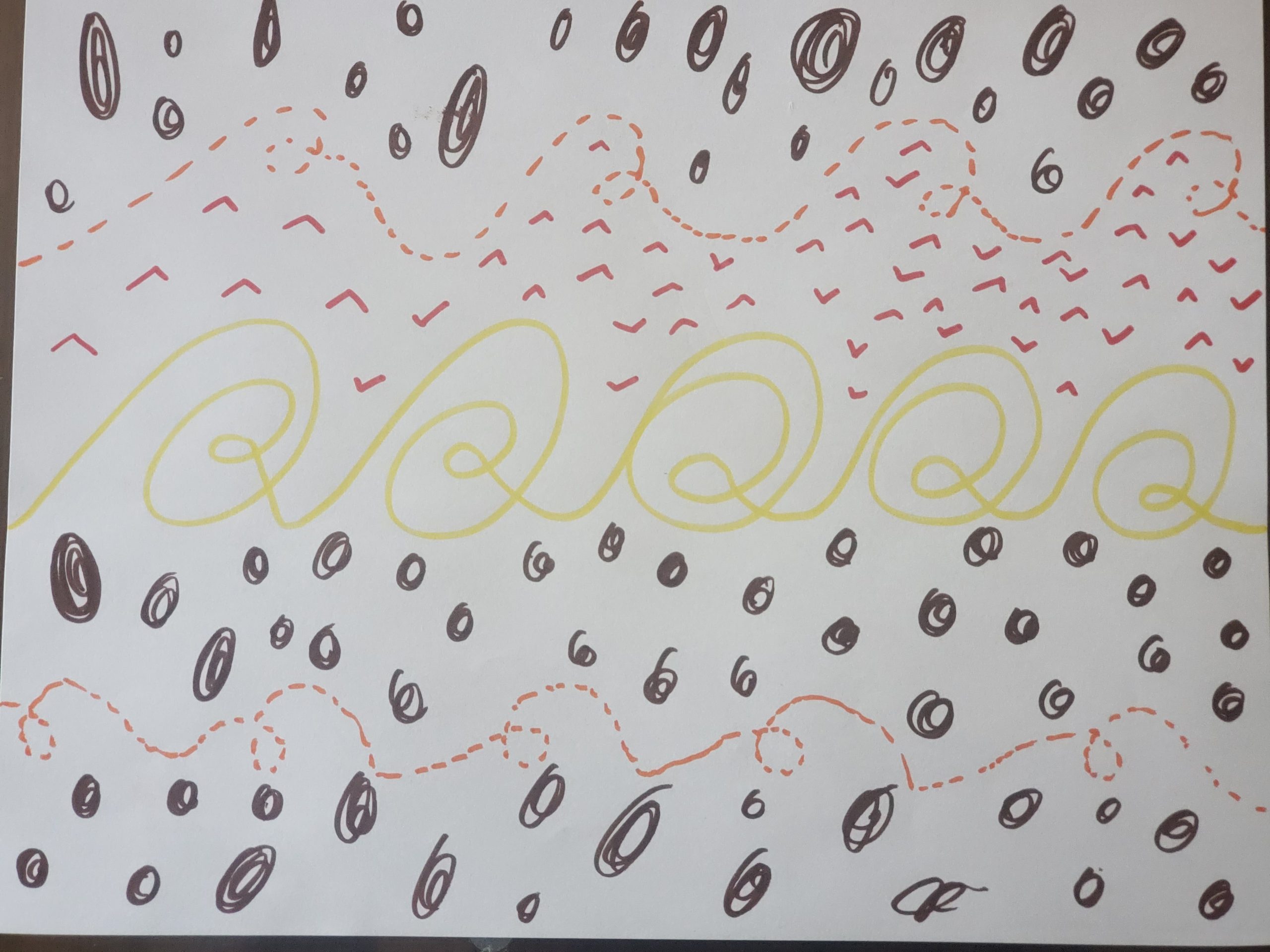
My sound map is inspired by the sounds I heard in our yard. I chose to use fall colors because when outside it feels and looks exactly like the middle of fall:
Brown: The brown squiggles represent my conversation with Raya. Our conversation was random and occurred in small spurts.
Orange: The orange dashed curves represent the sound of the cars driving on the highway. It was quiet and then there would be a ‘whoosh’ as the cars passed our yard.
Yellow: The yellow represents the wind. The wind was the loudest sound because it was very windy and cold. I made the wind the largest part of the map for this reason.
Red: The red represents the sounds of the geese flying south. I made the shape sharp and pointed because the sound was quick, but had a definitive peak in volume.
When translating the sounds into a visual process I noticed that it required paying more attention to the entirety of the sounds. By doing this I noticed that often I do not pay attention to the detail of the sounds I hear and where they are coming from. This aspect of sound is very important in creating and listening to music.
When I look at my sound map, I see an interpretation of fall. I see this because the shapes and colors remind me of falling leaves.
I like this activity because it is quick and easy. I remember doing this once in Band and enjoyed it. I can see this being a great activity to encourage students to think more deeply about the dynamics of the sounds they hear.
I also think that this activity is very versatile. The two main ways I would incorporate it into the classroom are the following:
Originally posted October 15, 2020.
For my first process journal, I chose to practice land-based arts education by creating a piece using junk.
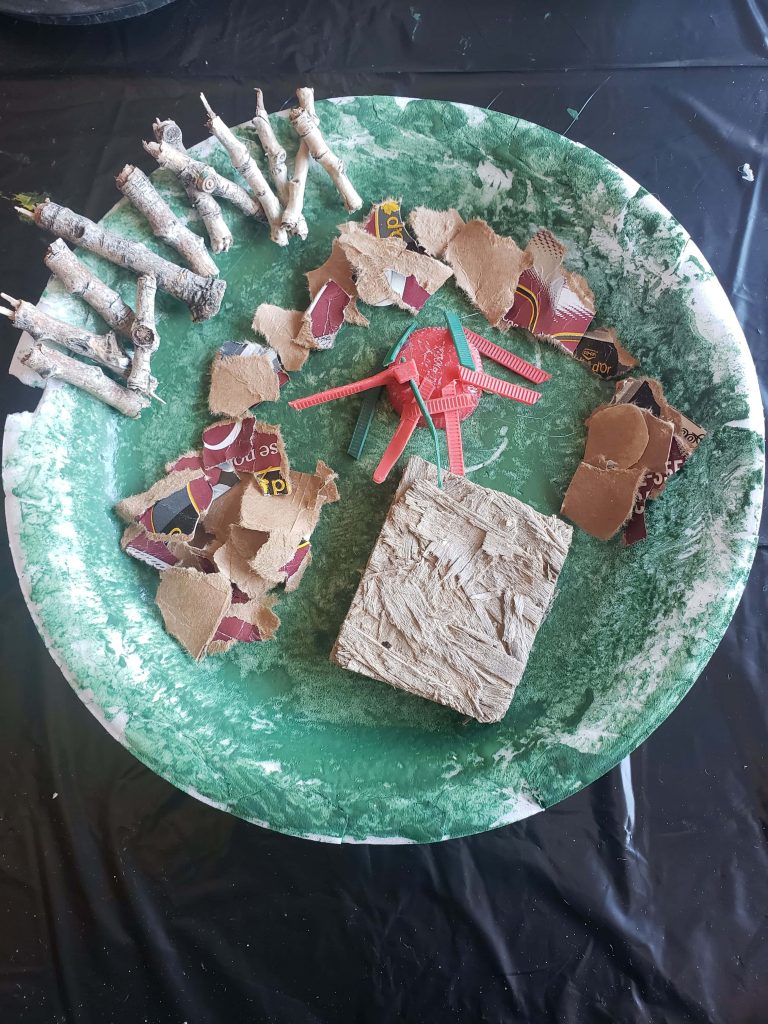
My Artistic Process
I am currently watching my boyfriend’s eight-year-old sister because she is sick and cannot be at school. So, I decided that we could both make our own land-based art. We began by walking around outside and we talked about what we saw, heard, felt, smelled, and tasted. When we were outside I noticed that there were a lot of leaves in the yard and most of the trees were empty. I also saw that her dad had a pile of junk piled up outside the door of his shop. In the pile were empty WD-40 cans, zip ties, pieces of plywood, pop bottle caps, and many other things. I decided to grab a few things from the pile to repurpose them. When we were outside I also grabbed a twig that had fallen to the ground. After about fifteen minutes I decided I wanted to represent what I saw outside using the junk I found in the pile and some natural materials.
When we came back inside we gathered a few materials that we could use.
For my junk art I used:
Styrofoam Plate: With our lunch that day we had left over pumpkin pie and we used Styrofoam plates, so I decided to use my plate as a canvas.
Green Acrylic Paint: I used the green acrylic paint to resemble the grass outside.
Plywood: I found a small piece of plywood in the pile outside and hot glued it to the plate. It is to resemble the shop.
Cardboard Box: I also found this box in the pile outside. Since the cardboard box was brown and burgundy I decided to use it to represent the leaves on the ground.
Coke Bottle Cap & Zip Ties: I found these in the pile outside. I though it was fitting to use them to represent the junk pile.
Twig: I broke the twig I found on the ground into pieces and glued it to the plate. The twig is to represent the trees I saw outside.
What did I learn from using the materials?
I learned that anything can be used to make art. The biggest takeaway for me from this assignment is that we can make art out of anything and use anything to inspire us. I liked the simplicity of going outside and picking up a few twigs and leaves and creating something different from it.
Classroom Applications
It was helpful to do this assignment with a child that is the age this type of activity is very well suited for because it gave me some ideas of how I could improve the activity and what students would like about it. I appreciated that we could both discuss our knowledge about the environment and apply it to what we made together. When we were each making our junk art we talked about how it was cool that we could use garbage to make art. Raya had a lot of fun doing this activity.
When Raya was making her junk art she was able to express her individual perspective and what we experienced outside. In her piece, she decided to paint the leaves and explained that the colors she painted them reminded her of fall and Halloween. From Raya’s experience, I know that this activity is process based and allows students to experiment.
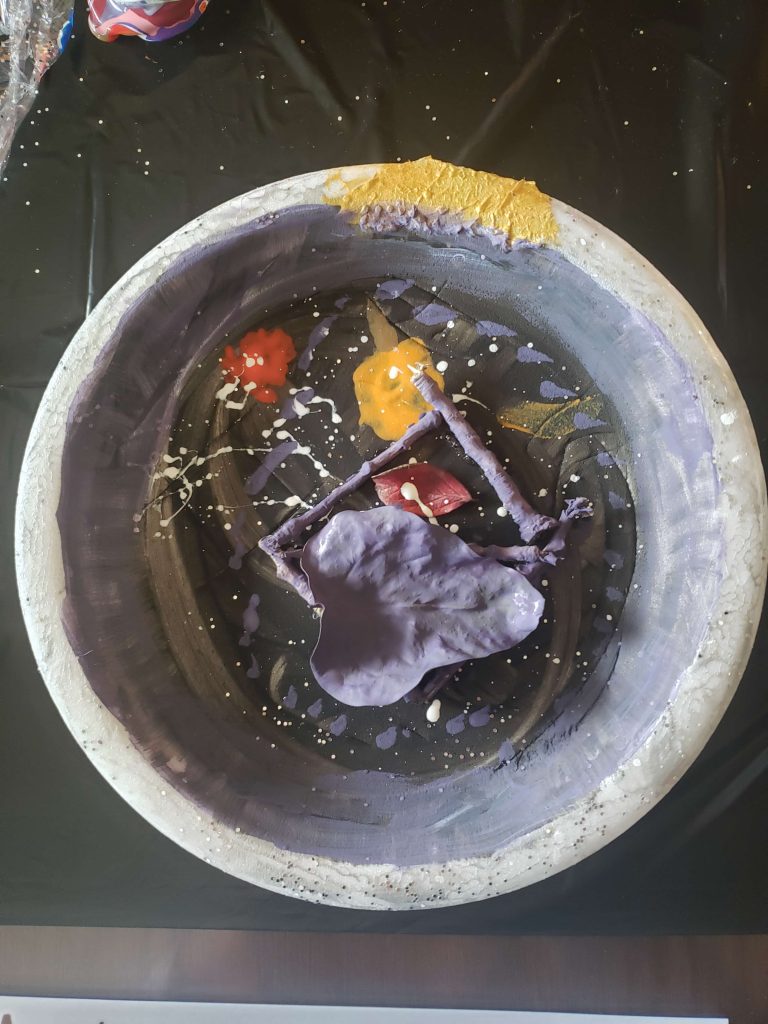
I believe in allowing students to express their own individuality and experiences in classroom activities and this activity allows them to do so.
How I would incorporate this activity into the classroom:
I think that this activity aligns well with the Grade 3 Saskatchewan Science Curriculum. For this reason I would use this activity to supplement both a science and art class. It would be great to start off by having a lesson that discusses the importance of recycling, reducing and reusing. After the lesson we could go outside for a reflection and complete the activity. Instead of having students pick up garbage from outside I would ask them to bring clean trash from home. I would also encourage them to grab natural materials that could be repurposed from outside.